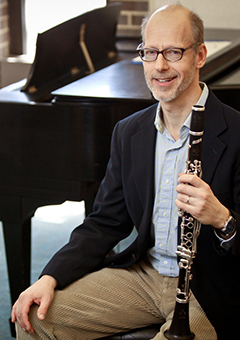Multiphonics
Quoted from Arthur H. Benade
A multiphonic oscillation is made up of a collection of components whose frequencies are connected to one another by an elaborate set of heterodyne (mixed frequency) relationships. The ordinary tones of woodwinds also fit this description, but the frequency components in normal tones are limited to those belonging to a single harmonic series.
A multiphonic oscillation is maintained by cooperations set up between several of the components and several of the taller peaks in the air-column resonance curve. Because neither the components nor the peaks need be in harmonic relationship, oscillation is not as easily maintained for multiphonics as it is for normal tones. The chief reason for the difficulty lies in the profusion of heterodyne components found in the inter-peak regions of the resonance curve.
The player must make rather subtle adjustments of his embouchure and blowing pressure in playing multiphonics. On the pianissimo side, the instrument may lapse into producing an essentially pure tone based on the tallest resonance peak, and on the loud-playing side the reed may simply choke up and snap closed if too many generated components lie at dips in the resonance curve.
Because of the great importance of heterodyne effects, multiphonics are most easily produced using reed and mouthpiece combinations that have a highly nonlinear flow-control characteristics and that include a great deal of sensitivity to Bernoulli forces at the reed tip. Such reed or mouthpiece combinations give bright or harsh-sounding normal tones.
The internally measured spectrum can change drastically when the player makes small changes in the size of the reed cavity (this is particularly true among conical instruments). The reason for this is that the cavity changes shift the frequency relationships among the air-column resonance peaks, and so upset the the often subtle interplay between them and the generated components. The relationship between internal and the external spectrum of a multiphonic sound is not the simple sort we find for more normal woodwind tones.
When we hear the conglomerate of partials making up a multiphonic sound, our hearing mechanism tends to pick from the collection sets of harmonically related or almost harmonically related components. Each of these sets is then heard as a tone of a more or less normal sort, having a pitch that is related in the normal way to the fundamental frequency of the set.
Our auditory habits of lumping a harmonically related set of partials into something that is perceived as a single tone explains why musicians give the name "multiphonic" to the sound we have been discussing. Each multiphonic, because it has sounds in it that are not harmonically related to each other, is perceived as being made up of a number of tones. The ordinary sound of a woodwind, being made up of a single set of harmonic partials, is perceived as a single tone.
A single, relatively strong component in the spectrum of a multiphonic sound is sometimes perceived as a separate tone in its own right if none of the other components present are even approximately related to it as harmonics. Apart from this special case, the strengths of the various partials as they come to our ears play a relatively small role in determining the way in which we group them into tones.

Contact
Gregory Barrett
NIU School of Music
1425 W. Lincoln Highway
DeKalb, IL 60115
815-753-8004
gregbarrett@niu.edu